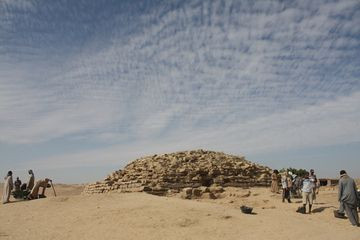4,600-Year-Old ‘Provincial’ Pyramid Discovered In Egypt, Older Than Great Pyramid Of Giza

Archaeologists in southern Egypt have unearthed an ancient step pyramid built around 2600 BC. The pyramid, determined to be one of seven “provincial” pyramids scattered throughout central and southern Egypt, was found near Edfu, the site of an ancient settlement located about 750 kilometers south of Cairo on the west bank of the Nile River.
According to Live Science, the recently discovered pyramid’s base measures 60 by 61 feet and it once stood as high as 43 feet tall. Weathering and pillaging have greatly degraded the 4,600-year-old pyramid, which now measures just 16 feet from its base to its tip. The Edfu pyramid predates the Great Pyramid at Giza by at least a few decades.
Archaeologists who excavated the ancient step pyramid said its construction was consistent with that of other provincial pyramids.
"The similarities from one pyramid to the other are really amazing, and there is definitely a common plan," Gregory Marouard, a research associate at the University of Chicago's Oriental Institute who led the work at the Edfu pyramid, said at a recent meeting of the Society for the Study of Egyptian Antiquities. "The construction itself reflects a certain care and a real expertise in the mastery of stone construction, especially for the adjustment of the most important blocks.”
The pyramid appeared to have been abandoned shortly after its construction, around the time Khufu, the Fourth Dynasty pharaoh who ruled Egypt during the 26th century B.C., began construction on the Great Pyramid. Archaeologists presented the results of their excavation at the symposium, which was held in Toronto.
Provincial pyramids, including the one uncovered at Edfu, had no internal chambers and were not meant for burials. Archaeologists continue to debate the purpose of these pyramids, but many believe they were symbolic of the power of the king.
“The location of small step pyramids in considerable distance to the established Old Kingdom royal cemeteries bestows upon these structures the character of non-funerary monuments that did not nor were intended to serve as a burial place of any kind,” archaeologists noted in their report. “Using the symbolic form without any trace of a funeral chamber or underground structure, it appears to have acted as a monument dedicated to the worship of pharaoh.”
Archaeologists did uncover the remains of babies and children who were buried at the base of the pyramid, but analysis showed the burials date to long after the pyramid was construced. Researchers also discovered inscriptions on the outside of the provincial pyramid at Edfu. The hieroglyphics depict a book roll, a red leaf, a bird, a seated man and a four-legged animal.
“These are mostly private and rough inscriptions, and certainly dedicated to the child/babies' burials located right under these inscriptions at the foot of the pyramid," Marouard told Live Science.
Archaeologists also found fragments of pottery in the sand surrounding the ancient pyramid. Much of it dated to the Old Kingdom, according to the report.
© Copyright IBTimes 2025. All rights reserved.






















